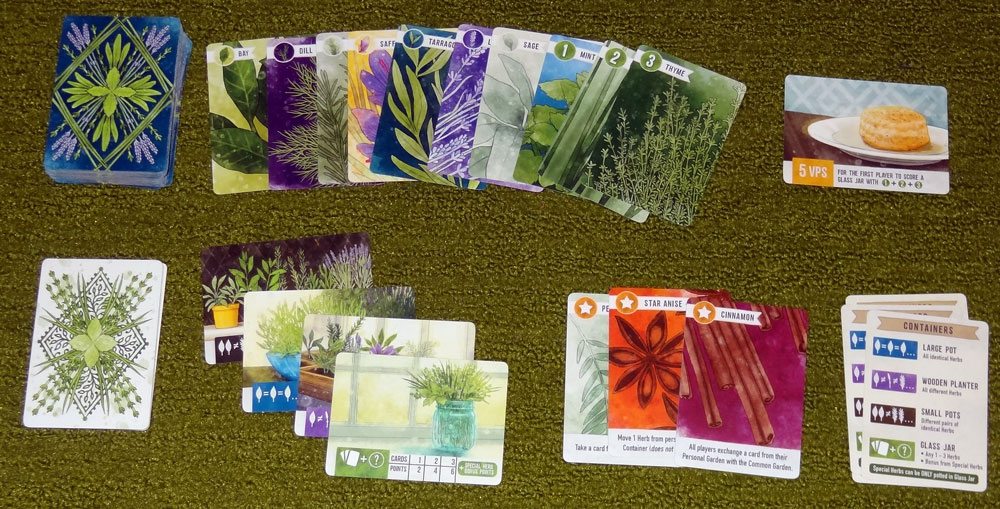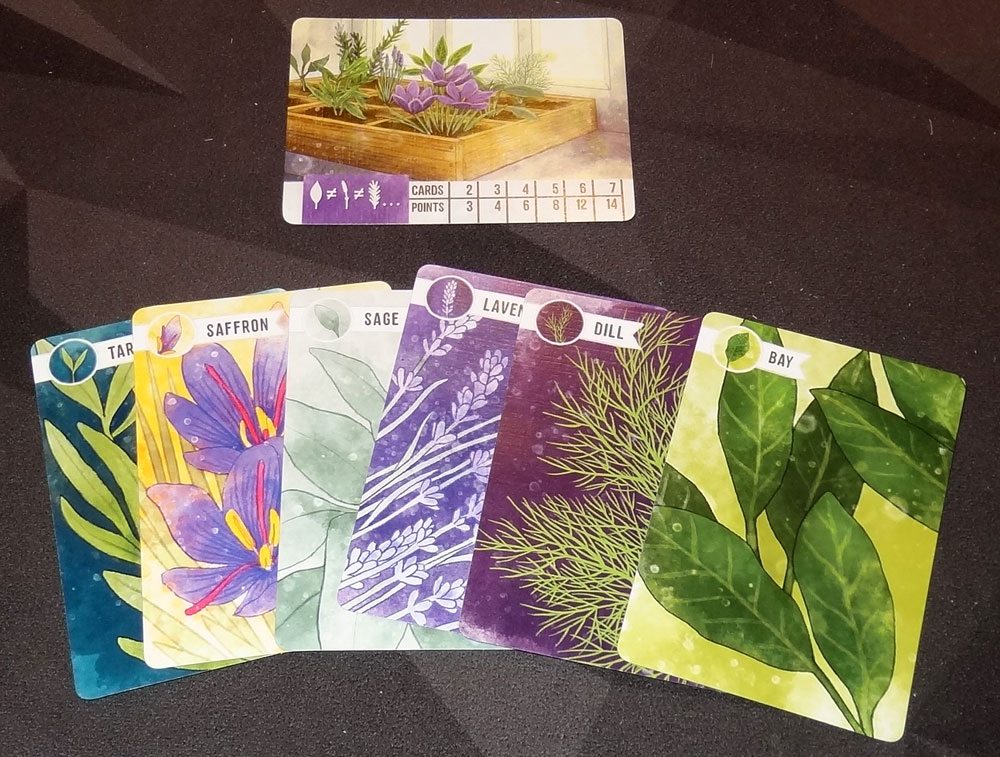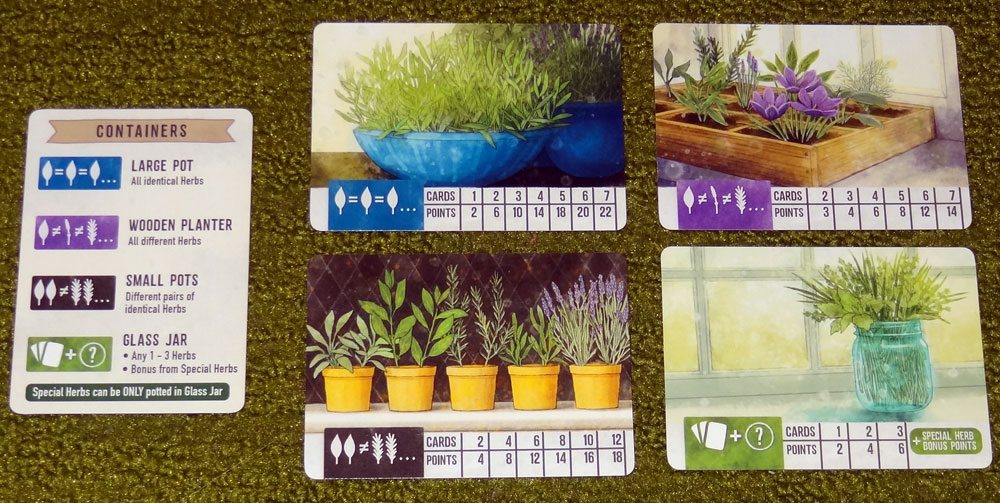In Herbaceous, you plant and pot herbs. (No, not that sort of herbs. Or that sort of pot.) It’s actually a gorgeous game about gardening.
At a glance: Herbaceous is a game by Steve Finn for 2 to 4 players, ages 8 and up, and takes about 20 minutes to play. It’s currently on Kickstarter, with a pledge level of $19 for a copy of the game. The game is family-friendly, both in theme and gameplay, but is also great for adults.
New to Kickstarter? Check out our crowdfunding primer.

Components:
- 63 Herb cards (9 each in 7 types)
- 9 Special Herb cards (3 each in 3 types)
- 16 Container cards (4 different containers per player)
- 1 Bun Reward card
- 4 player aid cards
- Kickstarter exclusive bonus: 3 Flavor cards

Herbaceous is all cards. I played with a prototype, but I believe the artwork and design is final and probably won’t change much. The cards all feature illustrations by Beth Sobel, and they’re lovely: colorful paintings of various herbs that are reminiscent of seed packets and will help get you in the right frame of mind for gardening.
The Container cards depict various types of containers to pot your herbs in, with some icons to indicate what sets of herbs can be put in each container and a scoring chart showing how many points you’ll get depending on how many cards are placed in the container.

The one odd thing is the Bun Reward card—it’s bonus points for the first person to pot one of each Special Herb, and I have no idea why it’s a bun on a plate. It just is. Maybe there’s something about gardening or herbs that I’m missing here, but I don’t know what this has to do with gardening, thematically. I mean, okay, it’s an herb bun, but did I make it? Did somebody make it for me because I gave them some nice herbs?
I’ve reviewed a few of Pencil First Games titles in the past and have seen the finished versions, and I trust Ed Baraf to make sure that the final components are nice quality and come in a cool package, too.

How to Play
You can download a copy of the rules here, or a Print and Play here if you want to try it out.
The goal of the game is to score the most points by potting combinations of herbs in your containers.
To set up, each player takes 4 different Container cards. The Herb cards and Special Herb cards are shuffled together into one deck. If playing with fewer than 4 players, a set number of cards is removed from the deck without looking at them. The Bun Reward card is set aside. Each player has an area in front of them called a Private Garden, and the center of the table is the Community Garden.
On your turn, first you may Pot Herbs if you want, and then you must Plant Herbs.

(Prototype shown) Photo: Jonathan H. Liu
To Pot Herbs, you choose one of your unused Containers, and then pick Herb cards from the Community Garden and Private Garden that will fit that container, tucking them under the Container card. Each Container has different rules: all identical cards, all different cards, different pairs of cards, and up to 3 cards of any type. The Special Herbs can only be planted in the Glass Jar, and are worth as many bonus points as indicated on the Special Herb card. In addition, if you’re the first to pot one of each type of Special Herb, you take the Bun Reward card, which is worth 5 points.
Each Container may only be used once during the game, and you may only use one Container per turn.
To Plant Herbs, you draw the top card of the deck, and choose to place it either in your Private Garden or the Community Garden. Then, you draw the next card and place it in the other location.
If you use up all of your containers, you will still take the Plant Herbs action but will no longer Pot Herbs.
The game ends when everyone has used up their Container cards or when it is impossible for anyone to pot anything.

Flavor Cards
The 3 Flavor cards are a Kickstarter exclusive that can add a little variant to the game. You shuffle the three, discard one (without looking) and then place one in each half of the Herbs deck. When the card is drawn, all players take the action listed on the Flavor card, which is then discarded, and then another Herb card is drawn to continue the turn.
- Star Anise: Move 1 Herb from your Private Garden to any Container.
- Peppercorn: Take a card from the player to your left.
- Cinnamon: Exchange a card from your Private Garden with the Community Garden.
The Verdict
Herbaceous is a refreshing breath of fresh air thematically—there are no monsters, no swords, no pirates, no spaceships, no magic: just a lot of beautiful herbs. And a bun on a plate—don’t forget the bun on a plate. Don’t get me wrong: I love monsters and swords and pirates and all that—but there are a lot of tried-and-true themes that get used very, very often in the world of tabletop games, and not as many themes that stand out. Sure, there are other games about gardening (and farming especially) but something about the realism of Beth Sobel’s illustrations made this one exceptional.
The gameplay itself is very straightforward, and easily learned. It’s a set collection game, with a very tiny dash of press-your-luck. To score points, you’ll need to get the biggest sets possible in each of your four containers. The Large Pot needs identical Herb cards: if you get all 7 of a kind, it’s a whopping 22 points, but that’s fairly unlikely. The question is, what is likely? Is it worth taking those 3 Lavender right now for 10 points, or should you wait to see if you can get 4 or 5? If you wait, will your opponents pick those Herbs before you get a chance?

The other complicating factor is that another pot needs pairs of Herbs, and another pot needs all different Herbs. So you’re not only competing against other players, but your sets are sort of competing against each other. Once potted, you can’t move things around, either. Deciding when to wait and when to pot is the key decision you’ll make while playing Herbaceous.
The slight bit of press-your-luck comes in the Plant Herbs phase. You draw a card, and decide whether it goes in your own personal stash or out where anyone can take it—but you know the next card will go in the other location. If you draw one of the Special Herbs first, that’s usually an easier decision because those are rare. But what if that means you add another Saffron to the Community Garden, allowing the next player to grab one more pair for their Small Pots? Should you plant this Rosemary in your own garden because you already have several Rosemary? Or should you plant it in the Community Garden in case the next card is that Tarragon you’ve been looking for?

The fact that the Pot Herbs phase comes before the Plant Herbs phase makes it a deliciously challenging choice. If you pick Herbs now, you may draw one more card for this set right after, and you’ll regret it. But if you don’t pick those Herbs from the Community Garden, who knows if they’ll be there by your next turn?
All of this plays out in about 15 to 20 minutes, too. Eventually the deck runs out and people have to plant from what’s available on the table, so you can’t wait too long before picking and potting or there won’t be much to choose from. I’ve tried it with different player counts and it feels pretty good no matter how many players you have (though setup is easiest with 4 because you don’t have to remove any cards).
If you want a fun card game to play when you’re not in the mood for slaying dragons or fending off zombies or building a civilization from scratch, Herbaceous is a nice pick fresh from the garden. Check out the Herbaceous Kickstarter page for more information.
Oh, and if somebody knows what the Bun Reward is all about, please tell me.



